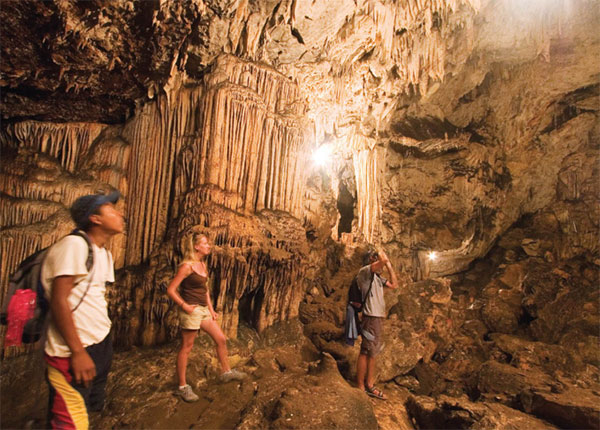FIESTA DE TODOS SANTOS
Guatemala is the land of festivals, but there’s one that tops them all: the Fiesta de Todos Santos. At the end of every October, Todosanteros (men from Todos Santos Cuchumatán) return to the village from all over Guatemala to celebrate the festival of All Saints (Todos Santos), the most famous in the country.
The festivities start the week before the horse race, which takes place on the morning of November 1 (All Saints’ Day). Music and dancing is held on October 31, in the costume of the next day’s race. Riders, most of whom have been drinking hard liquor all night, must circumnavigate a course around the town, stopping to take another swig of aguardiente after each lap and struggling to hang on. The ‘race’ in reality becomes a comical stampede, with the drunken jockeys urging their long-suffering steeds like demons possessed. The winner is the one who survives, still on his mount; all the riders gain considerable kudos, however, just for taking part.
On the next day, appropriately ‘the day of the dead,’ everyone moves to the cemetery for a day of eating, more drinking, and commemorating the lives of their dearly departed. Marimba bands play in the town center for days, and in the cemetery itself on November 2. Many traditional dances are performed, including the dance of the conquistadors.
The Verapaces contain some of the most beautiful scenery in the country, in places almost Swiss alpine in appearance; a large spread of cloud forest, home to the elusive quetzal; and some of the world’s best coffee-growing country.
Salamá ¤ [map] , the capital of the department, lies some 60km (37 miles) northeast of Guatemala City. The scenery around the town is a delightful mix of productive pastoral land (everything from oranges to olives are grown) and extensive pine forests. It is a historic place set in a wide river valley with an excellent Sunday market. The 17th century colonial church in the plaza is an absolute gem, with no fewer than 14 gilded altars.
Biotopo del Quetzal
The Biotopo del Quetzal ‹ [map] (daily 6am–4pm) is a sanctuary for the quetzal – once the spiritual talisman of the Maya lords, now Guatemala’s national bird – a beautiful but notoriously elusive creature that these days is very rare throughout Central America.

In the caves at Lanquín.
Corrie Wingate/Apa Publications
The preserve is a permanently humid patch of forest thick with ferns, epiphytes, moss, and lichen. Dawn is the best time to spot a quetzal, which feasts on the fruit of the aguacatillo (wild avocado) tree, but there are at least another 87 species of birds to look out for. A map available onsite details the two trails that meander through the ever-dripping foliage. The season for spotting the quetzal is just before and after the nesting season, between March and June.
Cobán
The commercial center of the Verapaces is Cobán › [map] , which, though founded by Las Casas in 1538, remained a slumbering backwater until the late 19th century, when large numbers of German immigrants arrived. The Germans were granted authority to plant coffee bushes, which thrived in the mild, moist Verapaz climate, and business prospered until World War II, when many of the coffee barons were expelled at the USA’s insistence because of their open support for Adolf Hitler.
TURTLES
The green turtle and olive ridley nest in Monterrico between July and November, and the leatherback between mid-October and February. All the turtles crawl ashore at night to lay 80–100 eggs.
Despite the protected status of the preserve, egg collectors comb the beaches at night, seeking out nesting turtles and taking the eggs, which are considered an aphrodisiac in Central America and so fetch a good price. Conservationists have set up two hatcheries on this section of the beach, however, and have had some success in persuading the egg collectors to donate a proportion of their cache. The collected eggs are protected until they hatch, when the baby turtles are released into the ocean. Around 10,000 baby turtles are released annually, though only a few dozen will reach maturity.
Tranquil Cobán makes an excellent base to explore the beautiful Verapaz scenery. Though the town maintains a sleepy demeanor, there are some good-value cafés and hotels. Take a stroll up to the Templo el Calvario, a fine old church dating from 1599, which is popular with Q’eqchi’ and Poqomchi’ Maya worshipers. Don’t miss the exquisite carvings and artifacts inside the small Museo El Príncipe Maya (Mon–Fri 9am–4pm), or the chance to take a guided tour of the Finca Santa Margarita (Mon–Fri 8am–12.30pm, 1.30–5pm, Sat 8am–noon), a coffee plantation southeast of the plaza. Once owned by prominent German coffee grower Erwin Dieseldorff, the guided tour takes you step by step through the coffee-making process from propagation to roasting. You also have a chance to sample the different types of Arabica coffee blends, and to buy beans direct.
Around Cobán: Languin and Semuc Champey
One of the most popular excursions from Cobán is Lanquín fi [map] , a lovely village around 60km (37 miles) to the east. The gargantuan Grutas de Lanquín (Lanquín caves; daily 8am–6pm) are a speleologist’s delight, stretching for several kilometers. Numerous tour companies offer trips here. Lanquín is also the perfect jumping-off point for Semuc Champey fl [map] , which is, put simply, one of the most beautiful places in Guatemala. A cascade of cool turquoise and emerald-green pools surrounded by lush, tropical forest, Semuc Champey is one of eastern Guatemala’s top tourist attractions. The Río Cahabón eventually flows into Lago de Izabal, but at Semuc Champey most of its current plunges underground, leaving a great limestone bridge at the surface. A little river water spills over this natural shelf, creating a series of idyllic pools perfect for swimming, and a magical place to relax and enjoy the magnificent natural setting (keep your valuables with you). Tour companies in Cobán run regular trips here.